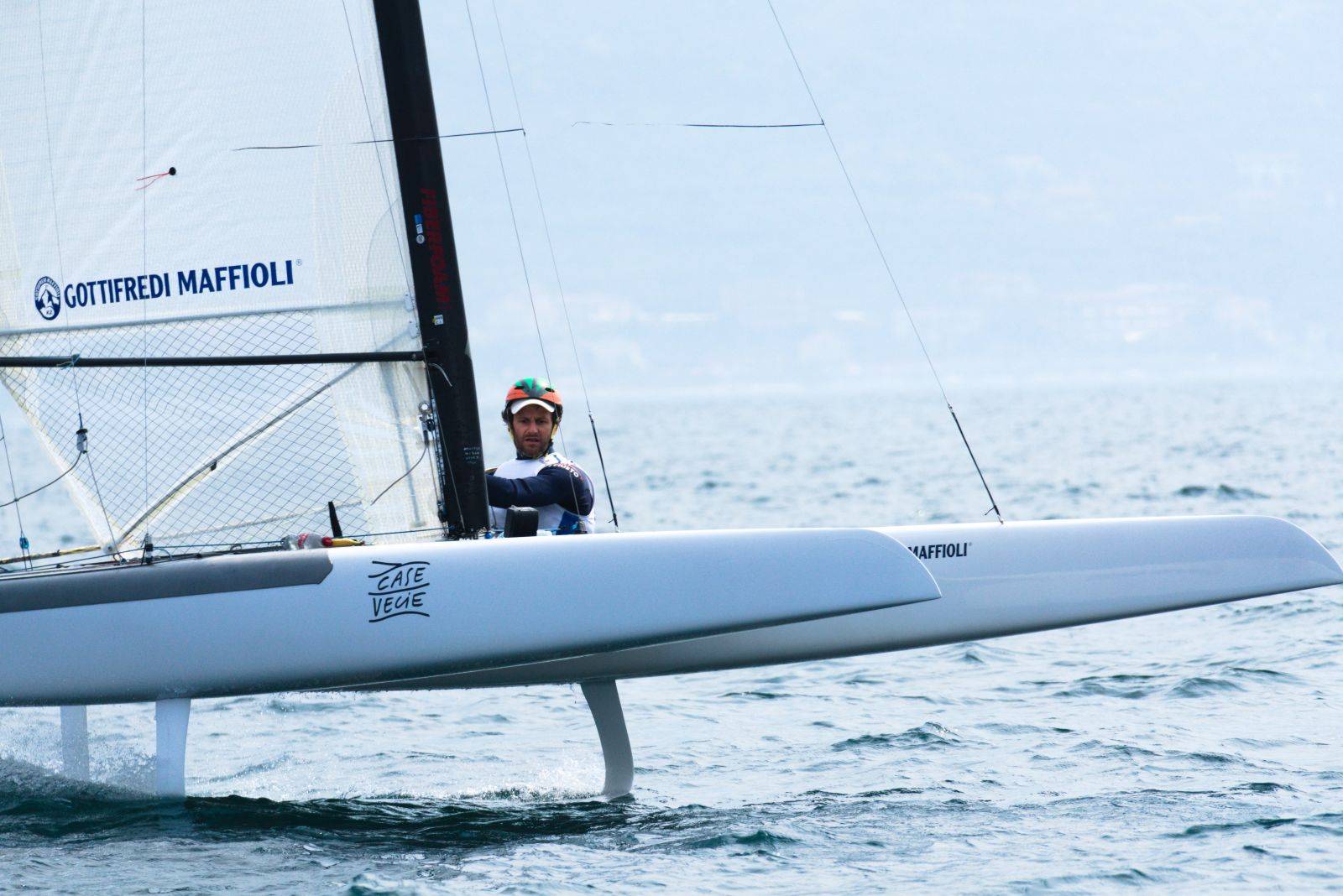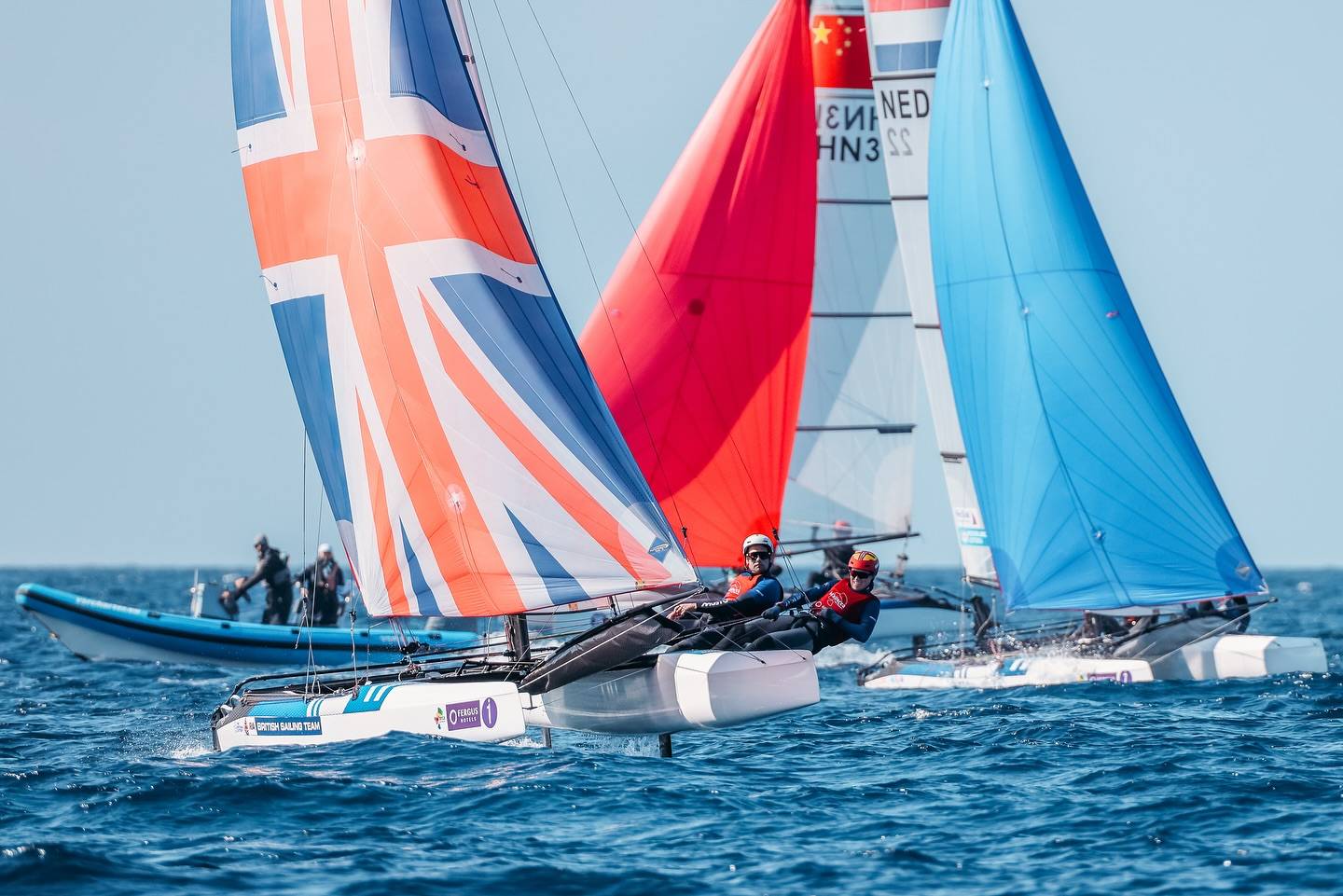Oracle 72 Capsize: Why?
Images Giulain Grenier / Oracle Team USA. . Clearly one of the best thing of this website was, and is still is, having direct access to some of the best brains in the design business. Really a sad view yesterday while seeing the rescue, but I’m glad the crew is Ok.
Yesterday I consulted Mike Drummond and Martin Fischer about the pitch.
Mike Drummond is currently in Florida for the 2012 A-Class Worlds and he is also in the process of answering a full interview I sent him some weeks ago.
He remarked that he was involved in the AC45 design, and he would have like a little more volume on the bows. Finally as we all saw, and I recognized later, it was more than a well designed platform. This after I said they needed more margin to handle the Wing power. It was just about the perfect design as the 45s were pushed quite hard by the best crews at Plymouth in the +25 knot range with no issues and some good recoveries.
“The AC45 is the best yacht I’ve been involved with. It’s nice to sail, it makes light airs interesting with speed and finesse, the wing is easy to handle. I would have liked more volume in the bow but it has proven mostly OK because most of the trouble has occurred from sailors taking risks, or plain mistakes”
 This confirmed by the latest pitch from Spithill at SF, that was more a ‘handling error’, see how high the windward hull is before the pitch, more coming from a fast starting reach where a closed angle bareaway is callling for trouble and also a gust hit, so you can´t call that was a design issue/failure.
This confirmed by the latest pitch from Spithill at SF, that was more a ‘handling error’, see how high the windward hull is before the pitch, more coming from a fast starting reach where a closed angle bareaway is callling for trouble and also a gust hit, so you can´t call that was a design issue/failure.
Seeing the AC72 video, there is No handling error in my view, it is a quite smooth safe progressive bareaway and even the pitch is not that extreme as Spithill 45 one past week.
Mike said that you always have trade offs and designers need to balance, windage and weight as one of the factors and points out the key compromise issue:
” The downside of extra bow volume is relatively small – more weight, more windage. The windage is not too bad, but the weight subtracts from the structure of beams etc. The downside of not enough Vol is immense, of course.”
—–
Martin Fischer feedback:
I asked Martin on the lessons learned on his F18 designs, that have evolved from the speedy but downwind tricky Capricorn to the added volume of the Phantom.
“In my opinion two factors drove the Oracle design team tosuch low volume hulls:
1/ windage and weight
2/ minimum drag for a boat with foils
The windage weight issue is easy to understand and I won’t go into details.
The more tricky thing is the understandable goal to minimise drag. For a given weight and a given length one may find an optimal range for the lengthto beam ratio.
If part of the weight of the boat is carried by a foil the hulls can / should be optimised for a lower weight, which leads to narrower hulls.
In theory a bear away even with a narrow boat isn’t a big deal, as long as the boat stays on the foils. But if something goes wrong with the foils the buoyancy of the hulls has to carry the whole load at very high speed. So at one point during the design process of a foiling boat a decision has to be made which trade off between safety margin and drag minimisation you aim for.
With the Wild Cat and the Phantom comparison you remark it is much easier. Without foils the
optimal hull width for an F18 is pretty wide and thus provides some safety margins.”
—–
 If you look well in the video the leeward hull is being lifted by the foil, generating a pitch down motion on the windward hull, just a detail as the hulls should have resisted that bow down and recover.
If you look well in the video the leeward hull is being lifted by the foil, generating a pitch down motion on the windward hull, just a detail as the hulls should have resisted that bow down and recover.
They’ve chosen San Francisco as the venue, so as I also wrote in past posts, no matter if they are going to fly all the way, chances are that you will have two hulls on the water at a given point, in the bareaway for instance… and there all the reduced drag concept will be the biggest drawback, right there in the most dangerous and tricky situation a racing cat can have.
ETNZ went bigge volume and we all could tell they will handle these kind of situations in a better form, maybe having Pete Melvin & Gino Morrelli also help them to go that way. Will try contact Pete later too.
So basically you have a design that aims to reduce drag for the flying stages of the course, the reason of the pitch can be totally assigned to that concept , more taking account on the venue & the high winds conditions expected for the Cup.
Tough times for Oracle and maybe for the Cup, but this is a design contest and that is the way it goes. Some might even be thinking now of racing with a soft sail??
The biggest Design Compromise is Not finishing the race, more if you are not even starting the next one…


























Great Article
https://www.youtube.com/watch?v=dSA7cs9WTXU&feature=youtu.be
Martin,
first off, complete respect to these guys, undoubtedly history will see them as 'The Game changers' for sailing and as a cat sailor I love that.
In the video piece it looks like in the initial phase the windward hull is flying, but then as the bare away begins it comes down quite early on adding unwanted weather hull drag. Tending to prevent or at best slow down the bare away phase holding the boat in the risk phase of this bare away for longer and making them more vulnerable to lee bow overload.
I wonder if the windward L foil was up hence bringing the hull down earlier than the crew expected. But I guess from other footage they sail upwind with only the lee L foil down anyway.
This could just be one of those 'figuring out how to sail a new boat' things.
Its not easy to see from the quality level of the footage.
What do you think Martin? I guess any extra bouyancy is just windage and they want to be right at the limit on this, it is the AC after all.
Best wishes
John Ready
GBR Hurricane 5.9SX & Tornado
The sailors had nothing to do here. They were handed a full foiling Lake racer for the mid range.
Don´t take my words on it, just read what Grant Dalton said after their own first bareaway, or what Fischer and Drummond commented.
This is no NASA science, no volume and you are going down right there on the bareaway, just ask Fischer on how his super refined World Title winning F18s have evolved too.
Even Oracle team said they had tiny hulls compared to ETNZ.
How Oracle pretend their racing crew to bareaway in those exterme conditions without any single margin of error is beyond my comprehension.